Design
Posted By:
Irina Lee
Monday 12 December 2011
Milton Glaser discussed the meaning of color and experimentation at the AIGA/NY Milton Glaser event on December 1, 2011 at Parsons The New School for Design Tishman Auditorium.
Stephen Doyle introduced the event by discussing his first experience with the work of Milton Glaser—a minimal black and white book cover for Shakespeare’s Julius Ceasar, a small drawing of Ceaser hunched over with a dot of red. Doyle was captivated with that detail which simply captured the essence of the play. Glaser eventually became Doyle’s teacher at Cooper Union, where Doyle learned from Glaser that “in design there are no absolutes. There are no rules. No rights. No wrongs. To design you have to create your own path, your own rules, and your own universe, and then you have to inhabit it.”
Glaser’s talk titled In Search of the Miraculous or One Thing Leads to Another was based on the ideas in his upcoming book, which is about working and the process of work. “You only understand anybody’s work after you see the continuity and the change that occurs in one’s history,” Glaser said.
Observed in his own personal experience, Glaser’s defines designers as serving clients and artists pursuing personal obsessions. This notion made Glaser wonder what would happen if designers pursued their own interests, and not the client’s.
The book was initiated in a time of idleness. Glaser started designing patterns and rugs because of his curiosity with lightness and darkness. Through experimenting with values and colors Glaser moved into directions that he could not anticipate. “You have to remove yourself from the practice, to benefit from the experience,” he said. This formative experience is cataloged in his book and clearly reveals the continuity and change between Glaser’s work.
Glaser’s interest in Buddhism, which shares some his own philosophies on connectedness, helped frame his approach for the work he designed at The Rubin Museum of Art (RMA). His approach extended into the identity, signage, and various printed materials.
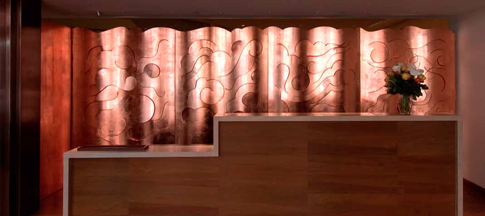
Upon entering the museum, attendees are greeted with a sculptural installation that clearly presents the tone of the RMA. This waving molded piece of metal has edges of carved lines forming clouds that catch the light in interesting ways.
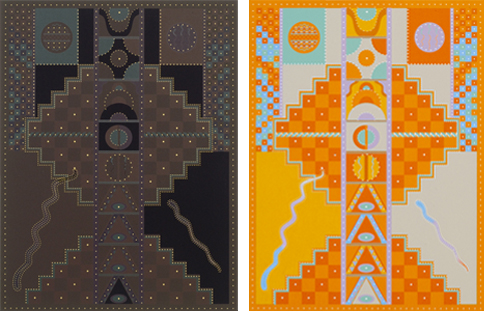
The RMA also commissioned a series of prints, which Glaser titled Tantra, capturing his fascination with simple shifts in color. Without compositionally changing any element on the page, the meaning of the print dramatically changed with the color shift. This exercise helped gauge and actualize Glaser’s lack of understanding of the profound importance of such seemingly rudimentary principle: color.
Glaser said, “one of the problems in professional life is that you never get the opportunity to change color, either arbitrarily or capriciously, because the use of color more often than not is found by the context, by the photograph, by whatever else you are doing, so we end up in the kind of work we do, generally being rudimentary in our sense of color change. And we never have the opportunity to play enough to understand what this change means.” That recognition helped fuel his experimentation and explorations with color over the following years.
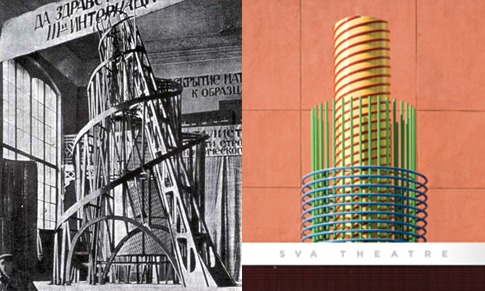
Inspired by The Homage to the Third Republic by Tatlin, Glaser’s entry sculpture for the School of Visual Arts Theatre combined horizontal, vertical and diagonal forms which resulted in a compelling intersections of color. Exploring how color can extend into the interiors, Glaser showed examples of the theatre’s bar with its undulating perforated pattern, and its ceiling with its accented strips of color. These forms and bursts of color transformed the space was transformed into a a completely different experience.
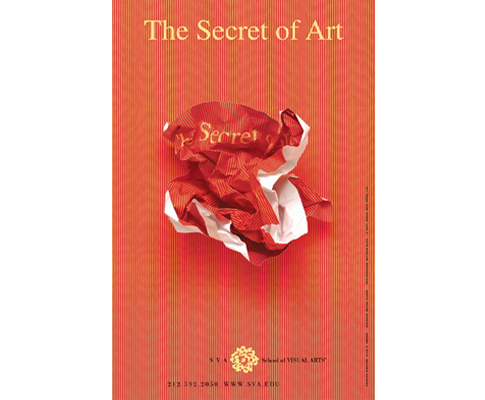
The poster that he designed for SVA helped Glaser recognize the importance of observation and the relationships the brain can create. Showing an image of a pattern that was a series of a simple yellow line that slightly thickens, he started to see a wave behind the yellow lines. It was an illusion created by the brain’s perception of form and color that helped inform his design decisions with the poster. After further exploration of the ilusion of movement through simple lines, he recognized the patterns presence and abstraction when the yellow lines were juxtaposed with the red.
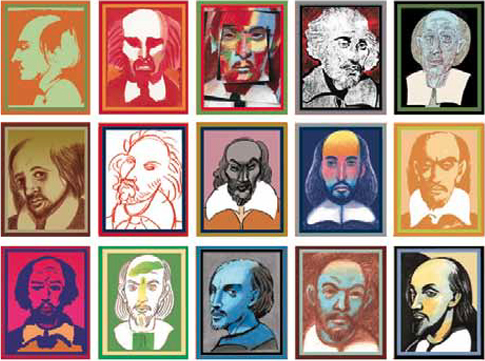
Glaser revealed that every portrait that he draws or paints of Shakespeare is unique. The future performance hall will have a mutli-floor projected image of Shakespeare that changes every few months. Additionally, the award sculpture he crafted for the center, has an iridescent paint that reflects color shifts depending on the viewer’s angle.
The Shakespeare portraits coupled with his interest in perception led into a series of experiments between two seemingly unconnected ideas: patterns and portraits. By juxtaposing these two elements in various ways, Glaser created a new result. “Art does it very often, it takes two unrelated events, color, themes, or something, and then forces them into a relationship, and you can take any two things in the universe and make them related, because everything is connected,” he said. With this series, Glaser wondered what becomes the focus, what becomes the message, and can either be separated now that they have been merged? At what point do you recognize what you’re looking at? But he understood that recognition is the basic instrument of communication
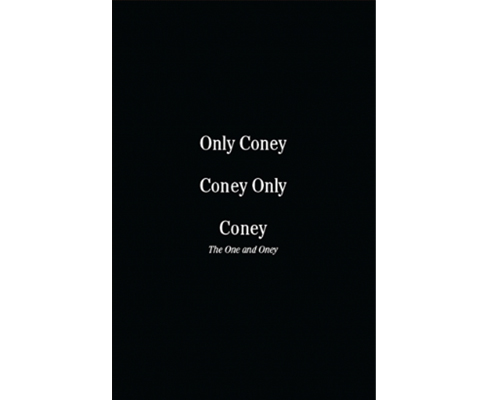
Glaser went on to talk about some of his failures of communication. Touching upon the work he did for Templeton, Brooklyn Brewery, and Coney Island, he asserted “the problem is that as designers, we have all to be clear about our intention, and we also have to make things understandable to a very specific audience as well as the client. But the imagination does not live in clarity. It lives in ambiguity. The imagination wants to be transgressive, it wants to do things in a way that has not been done before. It wants to violate expectation, it wants to penetrate pre-existing ideas. And it thrives on ambiguity and failures.” Glaser continued to say that the designer’s intention may be to be creative, but it may also violate the client’s intention to be clear. The designer needs to figure out a way to find a balance.”
Finally, Glaser concluded by stating, “art above all is transformative.” That idea is apparent in the work he’s explored throughout his career and his work these past five years may be the most notable examples of such a transformative relationship.
An audience Q&A concluded the event. When asked his role as designer, Milton Glaser said, “the role of any good designer is the role of a good citizen. No more no less.”
For more information, visit:
Milton Glaser
In Search of the Miraculous
To view event details, visit:
AIGA/NY Milton Glaser
Special thanks to guest blog contributor, Vijay Mathews, for writing the AIGA/NY Milton Glaser event recap. Vijay Mathews is the Partner & Creative Director at Winfield & Co., (@winfieldco) a digital design and development studio.